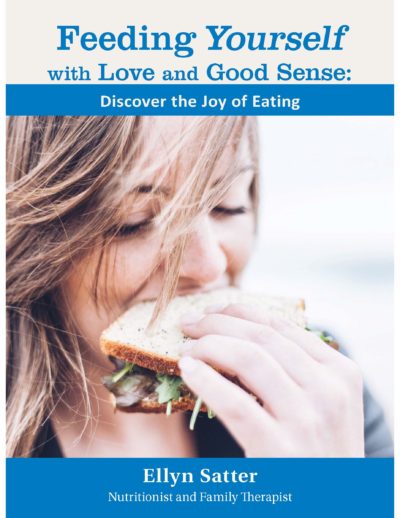Feeding with Love and Good Sense: 6 through 13 years
$0.00 – $400.00
Your newly independent, out-and-about, middle-years child may seem competent, but she is still a child, and she needs you as much as ever. This nifty booklet shows you how to continue to follow the division of responsibility in feeding and continue raising your child to be a good eater: enjoying eating, joining in happily with family meals, taking an interest in unfamiliar food, and growing in the way that is right for her. On the other hand, if your child is not a good eater, do not despair! Follow the guidelines in this booklet. She is still young, and when you change your ways with feeding, and keep them changed, she will change her ways with eating.
Your child’s eating jobs are to join in with family meals and snacks, to be good company at mealtime, and to pick and choose from the food you make available. Period. She is entitled to be free from worry about eating, moving, and weight. Reassure your child that she does not have to worry about family food. You will take care of that for her. She will be overwhelmed and frightened by negative and controlling messages about standards of athletic performance, calorie counting, food plans, eat-this-don’t-eat-that, good-food-bad-food, and weigh-this-don’t-weigh that. She needs you to protect her against those messages . . . and you need to protect yourself! Do not let anyone put your family food on a bad list or shame you for what you feed your family This is the third in the five-part series, Eating and Feeding with Love and Good Sense.
Feeding with Love and Good Sense: 6 through 13 years is appropriate for medical and educational settings, health care, public health, mental health, and public service.
- 6th grade reading level.
- 40 pages. 7.5 by 11 inches
- Full color, photos
Want thousands of this booklet? Contact us about a dedicated print run branded with your logo!
- Raise a healthy child who is a joy to feed Following the division of responsibility in feeding will help you raise your child to be a competent eater: To enjoy food, take an interest in unfamiliar food, eat as much as he needs, and value family meals.
- The best way to feed your child You are responsible for what, when, and where to feed your child, and for gradually teaching her to do the what, when, and where for herself. She is responsible for how much and whether to eat of the foods you put before her.
- Understanding your middle-years child As when your child was younger, identifying his stage in development depends on what he does, not how old he is. Now, his growth and development are more emotional and intellectual than physical, so transitions from one stage to the next are not as obvious. If all has gone well for him earlier, your 6- to 13-year-old child no longer has the toddler’s need to say “no” to show—and know—that he is independent. Knowing he is his own person frees him to learn and grow.
- How to feed your middle-years child The division of responsibility in feeding continues to be critically important in the middle years. Now, rather than your having to be physically present to enforce the rules about what, when, and where, you can expect your child to a good job with providing herself food when she is on her own.
- What to feed your middle-years child Once you have mastered the how of feeding, these food-management strategies can be helpful. On the other hand, they can be harmful if they feel like too many rules and take the pleasure out of eating.
- Raising your child in a food- and weight-crazy world Your eating-competent child feels good about eating, participates happily in family meals, matter-of-fact, sneaks up on new food and learns to eat it, and eats as much as she is hungry for. She is free from worry about eating, moving, and weight. But she is encountering people who will try to teach her to manage eating and weight the hard way.
- Solving feeding problems Consider the overweight child, the one who wants to diet, the picky eater, the one who won’t eat vegetables or drink milk, the breakfast-skipper, and the one who may be developing an eating disorder. The solution to all is following the division of responsibility in feeding.
- What you have learned Provide, don’t deprive, then love your child whatever his size and shape. Feel good about the child you have, not the one you thought you might have. Feel good about yourself, as well. You and your child can show each other what healthy and normal eating is all about.
Additional information
| Weight | 13 lbs |
|---|---|
| Dimensions | 10 × 11 × 12 in |


Reviews
There are no reviews yet.